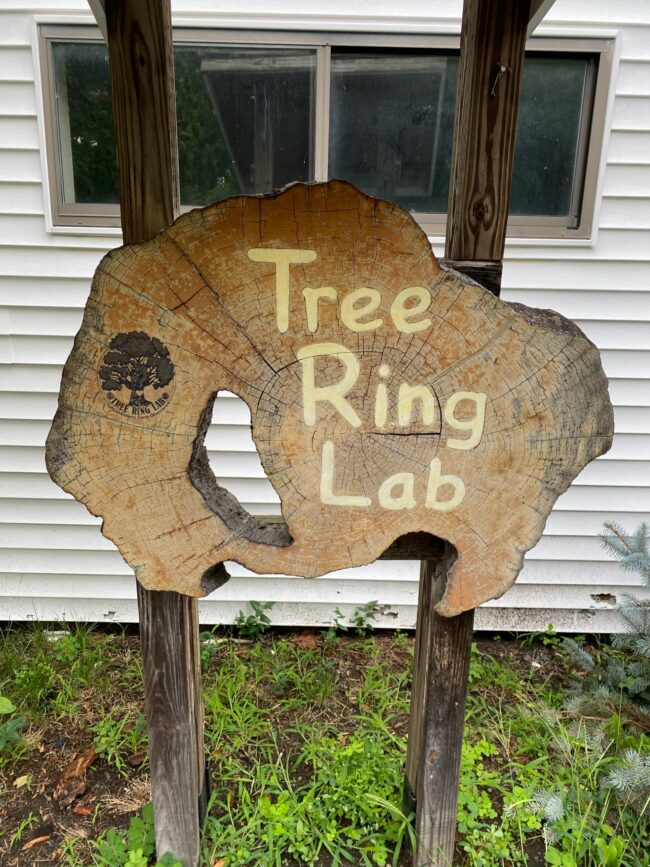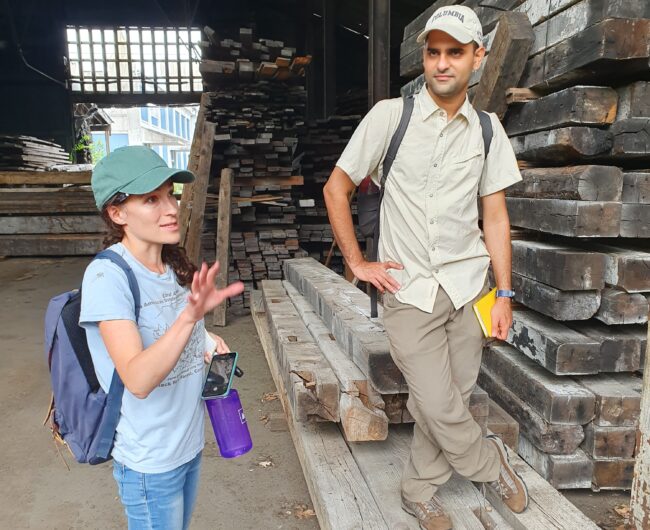One current early morning, Alan Solomon, owner of Sawkill Lumber, reached out to Mukund Rao , a dendrochronologist– a researcher that examines tree rings. The subject: old lumber beam of lights at a demolition site in New York City. If they relocated rapidly, they could intercede before the beam of lights were carted off to a land fill.
Why would old timbers be of wonderful rate of interest to both Solomon and Rao? A lumber-company owner and a scientist might feel like a not likely duo, however they are joined by an interest for maintaining historical document: Solomon through reconditioned floorboards and furnishings; and Rao, an assistant research study professor at the Lamont-Doherty Planet Observatory, as time capsules that indicate past climate conditions and details regarding centuries-old human background. Both Solomon and Rao are members of Save the Timbers– a team committed to rescuing old timber, a few of it going back millennia, that would certainly otherwise be discarded and forgotten.

After collecting samples from the hardwood at the demolition site, Rao brings them to his office at the Tree Ring Research Laboratory at the Lamont school in Palisades, New York City. (Lamont belongs to the Columbia Environment College.) There, scientists will certainly analyze the examples, competing against time to uncover the keys of old-growth trees before they’re shed forever.
“Lumber regenerates, yet old-growth woodlands take a long time to develop,” states Caroline Leland , a fellow dendrochronologist at the lab. “And every one consists of centuries of environmental data. It’s terrifying since once we throw them away, there’s no going back.”
With quotes ranging from under 10 percent to around 18 percent of old-growth woodland staying in the united state, we have actually shed a substantial part of these old communities– making their susceptability to fire, parasites, disease and logging a lot more disconcerting.
Deciphering History in the Tree Ring Laboratory
This year notes the 50 th wedding anniversary of the Tree Ring Laboratory, developed by Ed Cook and Gordon Jacoby with a give from the National Scientific Research Foundation in 1975 At that time, tree ring research was a young area, advancing from just dating wood to tracking droughts and temperature level swings. The Lamont Tree Ring Laboratory– among the initial worldwide– would certainly increase dendrochronology’s abilities over the years and end up being a worldwide leader in study, training and innovation.
The within the Tree Ring Lab is comfortable and academic, with carpeted floors and kitchenette. Its A-frame ceiling is lined with red steel beam of lights and equipment– residues of the structure’s past usage for making oceanographic devices prior to it was transformed for studying tree rings.

When examples are collected, Rao and Leland take a look at the tree rings under a microscope and usage high-resolution scanning to determine the widths of each ring. These information disclose exactly how wet, completely dry, hot or chilly the environment was when the tree lived, aiding researchers recognize problems from centuries ago.
After gathering information from several tree examples at a site, researchers contrast it with other chronologies– timelines of tree-ring data from various regions– frequently kept in on the internet databases or shared by colleagues. By doing this, they can produce lasting reconstructions, essentially assembling a historic document of environment changes like temperature level and dry spell over hundreds or even countless years, depending on the tree’s age. The information can after that be used to train environment designs, enabling researchers to much better anticipate future ecological problems.
The Tree Ring Laboratory researchers have actually rebuilded environment patterns covering greater than a millennium in areas across the globe, shedding light on phenomena such as megadroughts in the American West and extraordinary warming in Central Asia
Dendrochronologists have actually long utilized tree-ring information to reveal proof of severe climatic occasions, including global cooling triggered by volcanic eruptions like Mount Tambora in 1815 that set off the” Year Without a Summertime in 1816 They’ve likewise traced the origins of historic artefacts, consisting of an 18 th-century ship found below the Globe Trade Facility website, which came from an old-growth forest in the Philly area.

Mapping New york city’s Building Boom
One of Leland and Rao’s most substantial and preferred studies included the Terminal Storage facility in the Chelsea community of New York City. Initially built in 1891, this enormous structure as soon as worked as a vital business hub with railway running directly with the building to its Hudson River pier. From 1986 to 2001, the structure played host to the well known Tunnel bar, the train tracks carving out a location that ended up being the primary dance floor.
Throughout the peak of a significant remodelling in 2018, Leland and Rao had the opportunity to sample longleaf pine from recovered beams and map the beginnings of the hardwood. Their analysis revealed brand-new understandings: the tree-ring patterns carefully matched records from the Southeastern united state, showing that the wood had actually been harvested there and transported numerous miles to New York City.

This job, together with their various other research study carried out throughout metropolitan edifices in New York City in the last decade, helps document the history of iconic buildings and maps the comprehensive timber profession networks that helped with New york city’s fast development throughout the Gilded Age.
The city’s building boom depleted neighboring woodlands in the early 1800 s, compeling home builders to seek lumber from increasingly remote resources. By the mid-to-late 1800 s, New York was currently importing longleaf pine from as much southern as Georgia and the Carolinas. “One hardwood from the stockroom had rings from as early as 1512,” Rao claims. That very same varieties, longleaf want, was so prized for its toughness and resistance to rot that it was exported around the globe, showing up in historic buildings in the Low Countries (northwestern Europe) and as the product of a 19 th-century shipwreck off the coastline of Argentina
Demolition Waste and Its Ecological Impact
Though NYC is known as a city of high-rise buildings, actually, fewer than 2 percent of the city’s structures tower above seven tales tall. Greater than 95 percent of structures are believed to be made from wood-frame masonry and timber building, making the urban landscape a huge database of forest history. And these structures are continually being demolished to give way for brand-new ones.
While not every structure may be constructed from old-growth wood, numerous demolition authorizations are released annually throughout the five boroughs, with hundreds of construction allows for new structures subsequently being distributed, according to NYC’s OpenData platform.
“New York has basically no policies around preservation versus demolition. Unless a building has historical spots condition, it can be taken down without question,” says Rao. “Buildings come down throughout the city, and couple of are considering what’s inside or what has actually been tossed out.”
According to the Environmental Protection Agency, building construction debris represent one-third of the waste produced in the USA. Between 1970 and 2000 alone, 6 3 million older and historical real estate units were shed– some to fire or all-natural disaster, but several were knocked down to make way for new development or left to deteriorate beyond repair. That’s more than 500 systems a day, daily, for decades. If even half of those buildings had actually been preserved, substantial amounts of premium materials might have been drawn away from garbage dumps.
Taking down old structures likewise launches the kept carbon in hardwood. If wood winds up in land fills, it decomposes anaerobically and sends out methane– a greenhouse gas 28 times much more powerful than carbon dioxide. At once when New York City has actually committed to decreasing building emissions by 40 percent by 2030 and 80 percent by 2050 under Local Law 97 , disregarding these exhausts weakens these initiatives. [. ******]
New york city’s Below ground Round Lumber Economy
Despite growing climate understanding amongst New Yorkers and policymakers, the city still does not have a detailed round economy version to recuperate and reuse products from demolished structures. But some regional trendsetters are filling up the space. Brooklyn-based business like Sawkill Lumber, Tri-Lox, RE-CO BKLYN and Bien Hecho redeem wood from buildings slated for demolition or from downed city trees, transforming ignored products right into furniture, architectural attributes and also museum-quality installations.
Sawkill Lumber’s warehouse in Crown Levels, Brooklyn constantly gives off material and aged want. The timber is sent out to a mill in Connecticut, where employees invest their days thoroughly de-nailing huge floor joists and hardwoods, and take them through an extensive re-manufacturing procedure. Inventory is organized by types, source and dimension. Some beam of lights gauge 12 inches wide and stretch over 24 feet long, standing for longleaf yearn, Eastern white pine or a rare hairless cypress tree ( Taxodium distichum that made use of to control swamps and wetlands across the southeastern U.S. in the very early 1600 s.

“This is material you just can not find in a woodland anymore,” claims Solomon, who established Sawkill Lumber in 2007 Solomon began the company with an objective: to rescue and repurpose rare old-growth wood from NYC before it disappears right into dumpsters and debris piles. “The resilience, provenance and beauty of this wood is unrivaled by anything available today.”
These antique beam of lights will be born-again as flooring, tables and furniture, or building details in a series of property and industrial projects throughout New York City and beyond– typically fetching higher rates than newly grated lumber. Still, the business economics of salvage are much from very easy.
“We increasingly have to bid for the product that is managed by demolition companies. They would certainly otherwise pay to throw away it, but still require further motivation,” Solomon claims. “However the labor prices are significant, and we can just salvage a fraction of what’s offered.”
Just later on at Bien Hecho in the Brooklyn Navy Yard, the group is reincorporating recovered wood right into the very structures it came from. In one recent job, the team partnered with Worrell Yeung Architects to restore thousands of feet of initial heart ache beam of lights from a six-story 1920 s factory near the lawn. That same wood now greets site visitors in the kind of a custom-built seminar table and bench, went back to the website as treasures.
Still, without standardized processes to divert recyclable products– or rewards for designers to deconstruct instead of destroy, high-value wood continues to be sent out to land fills. Deconstruction takes more time and labor, which usually makes it financially uninviting in New york city’s fast-moving realty market.
A Vision for a Round Future
Other cities offer compelling designs. Rose city, Oregon, passed a deconstruction regulation in 2016 needing hands-on taking down, instead of mechanical demolition, for homes developed prior to 1940 A research from Oregon’s Division of Environmental High quality discovered that each deconstructed home conserves roughly 7 6 statistics lots of CO 2 e and can produce on average 6, 000 board feet of multiple-use lumber. That exact same house, if demolished, generates 127 lots of debris. Influenced by Portland, cities like Seattle and San Antonio have actually released their very own programs.

“If New york city applied similar requirements for structures over 80 years old, we could draw away hundreds of tons from garbage dumps while preserving irreplaceable materials,” says Solomon.
By partnering with salvage firms like Sawkill, researchers like Leland and Rao are developing a peaceful but efficient bridge between scientific research and salvage– ensuring that irreplaceable wood and the data it holds don’t go to waste.
A regional campaigning for team called RECLAIM NYC is pushing for policies to advertise tools and campaigns that generate demand, help with supply and connect salvaged items with reuse opportunities.
“The demolition firms are in fact satisfied when we connect to them,” claims Rao. “Otherwise, they need to pay one more contractor to take away the lumber. It’s much better for them if we can collaborate with salvage procedures.”
REDEEM New York City’s vision is vibrant yet functional. They suggest leveraging existing platforms and markets to share information on offered material– such as pictures, quantities and timelines– before deconstruction takes place. To support broader reach, they likewise suggest that NYC invest in regional storage space and transport framework to produce buffer time and boost the logistics of connecting supply with demand.
The stakes continue to grow. In April 2025, federal defenses were curtailed on almost 60 percent of U.S. national forests, opening up greater than 112 million acres to logging, mentioning the danger of wildfires, parasites and conditions. As wood manufacturing increases, reusing what’s currently been cut is much more important than ever, especially for dendrochronologists who rely on these old-growth forests for data.
“Next time you pass a demolition site in New York,” says Leland, “take a moment to look at the exposed beams. They’re not simply scraps of old building and construction– sometimes, they’re the last living traces of forests that predate European negotiation. The concern is whether we’ll see their worth before it’s too late.”